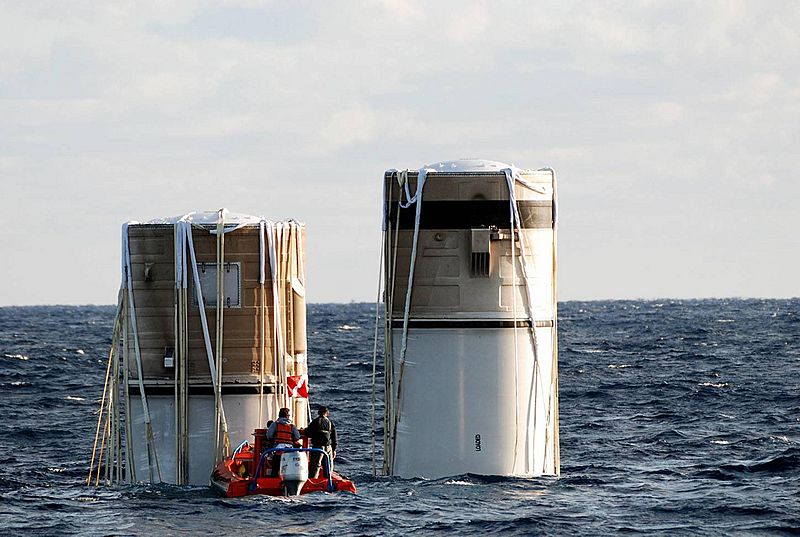Image: STS-116 rocket boosters (NASA KSC-06PD-2794)

Description: KENNEDY SPACE CENTER, FLA. -- Floating in the Atlantic Ocean about 150 miles north east of Cape Canaveral are the right and left solid rocket boosters, which were jettisoned from the Space Shuttle Discovery two and a half minutes into the ascent to orbit on Dec. 9, 2006. Though the boosters landed in the ocean miles from each other, overnight wind and ocean currents allowed the left booster, which was floating higher in the water, to migrate to the location of the right booster. The SRB retrieval team monitored the boosters through the night, and confirmed that the boosters did not contact each other. Both boosters were towed back to Hangar AF at the Cape Canaveral Air Force Station, where the refurbishment operations are now underway. Discovery lifted off from KSC's Launch Pad 39B at 8:47 p.m. EST on mission STS-116. For more information about the process of retrieval, go to http://www-pao.ksc.nasa.gov/kscpao/nasafact/pdf/SRBships06.pdf and http://www.nasa.gov/mission_pages/shuttle/behindscenes/recovery_ships.html. This was the second launch attempt for mission STS-116. The first launch attempt on Dec. 7 was postponed due a low cloud ceiling over Kennedy Space Center. This is Discovery's 33rd mission and the first night launch since 2002. The 20th shuttle mission to the International Space Station, STS-116 carries another truss segment, P5. It will serve as a spacer, mated to the P4 truss that was attached in September. After installing the P5, the crew will reconfigure and redistribute the power generated by two pairs of U.S. solar arrays. Landing is expected Dec. 21 at KSC.
Title: STS-116 rocket boosters (NASA KSC-06PD-2794)
Credit: http://mediaarchive.ksc.nasa.gov/detail.cfm?mediaid=30785
Author: No copyright protection is asserted for this photograph. If a recognizable person appears in this photograph, use for commercial purposes may infringe a right of privacy or publicity. It may not be used to state or imply the endorsement by NASA employees of a commercial product, process or service, or used in any other manner that might mislead. Accordingly, it is requested that if this photograph is used in advertising and other commercial promotion, layout and copy be submitted to NASA prior to release. PHOTO CREDIT: NASA or National Aeronautics and Space Administration
Permission: Public domainPublic domainfalsefalse This file is in the public domain in the United States because it was solely created by NASA. NASA copyright policy states that "NASA material is not protected by copyright unless noted". (See Template:PD-USGov, NASA copyright policy page or JPL Image Use Policy.) Warnings: Use of NASA logos, insignia and emblems is restricted per U.S. law 14 CFR 1221. The NASA website hosts a large number of images from the Soviet/Russian space agency, and other non-American space agencies. These are not necessarily in the public domain. Materials based on Hubble Space Telescope data may be copyrighted if they are not explicitly produced by the STScI.[1] See also Template:PD-Hubble and Template:Cc-Hubble. The SOHO (ESA & NASA) joint project implies that all materials created by its probe are copyrighted and require permission for commercial non-educational use. [2] Images featured on the Astronomy Picture of the Day (APOD) web site may be copyrighted. [3] The National Space Science Data Center (NSSDC) site has been known to host copyrighted content. Its photo gallery FAQ states that all of the images in the photo gallery are in the public domain "Unless otherwise noted."
Usage Terms: Public domain
License: Public domain
Attribution Required?: No
Image usage
The following 3 pages link to this image:

